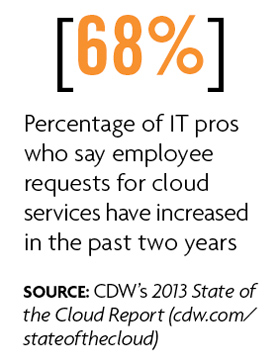How Businesses Can Maximize the Benefits of the Cloud
Clearly, cloud computing offers a host of opportunities to the startup or small to medium-sized business — from reduced capital outlays to immediate access to the latest versions of hardware and software.
Today, technology leaders at small businesses increasingly consider cloud services an essential component of their IT toolkit.
Over the past year, small businesses have been some of the most aggressive adopters, according to CDW’s 2013 State of the Cloud Report. In the case of small businesses, 42 percent of survey respondents used cloud offerings in 2012, compared with 21 percent in 2011. For midsize companies, the figures are 40 percent, up from 21 percent the previous year.

A chief driver, whether for software, platform or infrastructure as a service, is the adoption of cloud technology for personal use. Our research found that 70 percent of IT professionals at small businesses report that their own use of cloud services has helped spearhead its adoption at work.
That’s a telling fact that mirrors what’s happening with mobile device use in the workplace as well. Call it the consumerization of the cloud.
In addition to their personal use of cloud tools, the majority of the 1,242 IT professionals we surveyed for the report (73 percent) also say that the broad use of cloud applications and mobile devices by employees has significantly influenced their organizations’ cloud migration. That’s less of a factor for small-business IT pros (45 percent), but it’s still affecting their tech strategies.
More Players, More Dollars
The cloud report’s data points to a shift in thinking that’s taking place in the workplace. Although a business’s CIO staff or IT department is expected to have an overarching view and strategy for the corporate technology environment, which includes keeping data and IT assets safe, the IT team doesn’t necessarily control the technology roadmap when it comes to mobility and cloud technology.
Although IT directors, CIOs and chief technology officers remain the most influential folks on the management team when it comes to making cloud decisions, other C-level executives are playing a major role as well, according to the survey data. Why? The reason seems to be the bottom line: Senior managers are encouraging their IT organizations to find more ways to shift capital investments to operating expenses. Obviously, cloud services can help with that.
That plays out in how small and medium-sized businesses are using cloud technology. Storage is the top cloud service among both small and midsize companies, at 40 percent and 34 percent, respectively. Moving that hardware footprint off premises provides immediate and repeatable savings in capital investment.
What does all of this mean for your business?
If you’ve been a bit cloud-shy because of security concerns (the No. 1 issue noted by small businesses) or performance factors (that’s No. 2), it doesn’t mean that all of your on-premises tools aren’t needed.
It does suggest that adding cloud to the mix makes sense when your particular needs match up with the services available.








